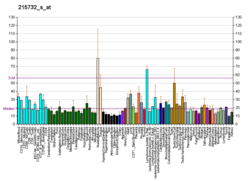Protein deltex-2 also known as E3 ubiquitin-protein ligase DTX2 is an enzyme that in humans is encoded by the DTX2 gene.[5]
DTX2 functions as a ubiquitin E3 ligase in conjunction with the E2 enzyme UBCH5A.[6]
References
- 1 2 3 ENSG00000091073 GRCh38: Ensembl release 89: ENSG00000282379, ENSG00000091073 - Ensembl, May 2017
- 1 2 3 GRCm38: Ensembl release 89: ENSMUSG00000004947 - Ensembl, May 2017
- ↑ "Human PubMed Reference:".
- ↑ "Mouse PubMed Reference:".
- ↑ "Entrez Gene: DTX2 deltex homolog 2 (Drosophila)".
- ↑ Takeyama K, Aguiar RC, Gu L, He C, Freeman GJ, Kutok JL, Aster JC, Shipp MA (2003). "The BAL-binding protein BBAP and related Deltex family members exhibit ubiquitin-protein isopeptide ligase activity". J. Biol. Chem. 278 (24): 21930–7. doi:10.1074/jbc.M301157200. PMID 12670957.
Further reading
- Matsuno K, Diederich RJ, Go MJ, et al. (1995). "Deltex acts as a positive regulator of Notch signaling through interactions with the Notch ankyrin repeats". Development. 121 (8): 2633–44. PMID 7671825.
- Kishi N, Tang Z, Maeda Y, et al. (2001). "Murine homologs of deltex define a novel gene family involved in vertebrate Notch signaling and neurogenesis". Int. J. Dev. Neurosci. 19 (1): 21–35. doi:10.1016/S0736-5748(00)00071-X. PMID 11226752.
- Yamamoto N, Yamamoto S, Inagaki F, et al. (2002). "Role of Deltex-1 as a transcriptional regulator downstream of the Notch receptor". J. Biol. Chem. 276 (48): 45031–40. doi:10.1074/jbc.M105245200. PMID 11564735.
- Benzinger A, Muster N, Koch HB, et al. (2005). "Targeted proteomic analysis of 14-3-3 sigma, a p53 effector commonly silenced in cancer". Mol. Cell. Proteomics. 4 (6): 785–95. doi:10.1074/mcp.M500021-MCP200. PMID 15778465.
- Hiller M, Huse K, Szafranski K, et al. (2007). "Single-nucleotide polymorphisms in NAGNAG acceptors are highly predictive for variations of alternative splicing". Am. J. Hum. Genet. 78 (2): 291–302. doi:10.1086/500151. PMC 1380236. PMID 16400609.
- Lim J, Hao T, Shaw C, et al. (2006). "A protein-protein interaction network for human inherited ataxias and disorders of Purkinje cell degeneration". Cell. 125 (4): 801–14. doi:10.1016/j.cell.2006.03.032. PMID 16713569.
- Yi Z, Yi T, Wu Z (2007). "cDNA cloning, characterization and expression analysis of DTX2, a human WWE and RING-finger gene, in human embryos". DNA Seq. 17 (3): 175–80. doi:10.1080/10425170600857616. PMID 17286044.
External links
This article incorporates text from the United States National Library of Medicine, which is in the public domain.
|
|---|
|
(2) Zinc finger DNA-binding domains |
|---|
| (2.1) Nuclear receptor (Cys4) | | subfamily 1 | |
|---|
| subfamily 2 | |
|---|
| subfamily 3 | |
|---|
| subfamily 4 | |
|---|
| subfamily 5 | |
|---|
| subfamily 6 | |
|---|
| subfamily 0 | |
|---|
|
|---|
| (2.2) Other Cys4 | |
|---|
| (2.3) Cys2His2 | |
|---|
| (2.4) Cys6 | |
|---|
| (2.5) Alternating composition | |
|---|
| (2.6) WRKY | |
|---|
|
|
|
(4) β-Scaffold factors with minor groove contacts |
|---|
|
|
(0) Other transcription factors |
|---|
|
|
see also transcription factor/coregulator deficiencies |




